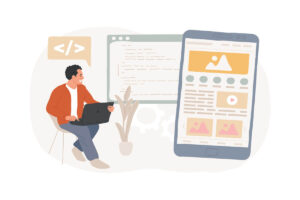When it comes to developing mobile applications, choosing between Android and iOS platforms can be a challenging decision for many businesses. One of the key factors that businesses consider is the cost of development for each platform. In this article, we will delve into a detailed comparison of Android and iOS development costs to help you make an informed decision for your next mobile app project.
1. Overview of Android Development Costs
– Development Tools
Android development primarily uses Java and Kotlin as the programming languages, along with Android Studio as the Integrated Development Environment (IDE). These tools are free to use, which can help lower the overall development costs.
– Device Fragmentation
One of the challenges in Android development is the wide range of devices with different screen sizes, resolutions, and hardware specifications. This can lead to additional development and testing efforts, which may increase the overall development costs.
– App Distribution
Android apps are typically distributed through the Google Play Store, which requires a one-time registration fee of $25. This cost is relatively low compared to the App Store fees for iOS apps.
– Development Time
Due to the device fragmentation and testing efforts required for Android apps, the development time may be longer compared to iOS apps. This can potentially increase the overall development costs. Additionally, developers may need to allocate additional time for optimizing the app for various devices, which can impact the project timeline.
– Cost Considerations
While the development tools for Android are free, businesses need to consider the cost of hiring experienced developers who are proficient in Java and Kotlin. The expertise required to navigate the challenges of device fragmentation and optimize the app for different screen sizes can also contribute to the overall development costs.
– Testing Efforts
With a wide range of devices to consider, testing an Android app thoroughly can be time-consuming and may require additional resources. Businesses need to allocate sufficient time and budget for comprehensive testing to ensure the app functions seamlessly across various devices and screen resolutions.
2. Overview of iOS Development Costs
– Development Tools
iOS development uses Swift and Objective-C as the programming languages, along with Xcode as the IDE. While Xcode is free to use, businesses need to own a Mac device to develop iOS apps, which can be an additional cost.
– Device Compatibility
Unlike Android, iOS has a more limited range of devices, which can simplify the development and testing process. This streamlined process can help reduce development costs.
– App Distribution
iOS apps are distributed through the Apple App Store, which requires an annual fee of $99 for the Apple Developer Program. This cost is higher compared to the one-time fee for the Google Play Store.
– Development Time
Due to the streamlined development process and limited device compatibility, iOS apps may have a shorter development time compared to Android apps. This can potentially reduce the overall development costs. Moreover, developers can leverage the consistent user experience across Apple devices to streamline the design and development process.
– Investment in Apple Ecosystem
In addition to the development costs, businesses need to consider the investment in the Apple ecosystem, including purchasing Mac devices for development and testing. While this can be an upfront cost, it may streamline the development process and reduce long-term expenses associated with device fragmentation.
– Quality Assurance
With a more controlled environment, testing an iOS app may be more straightforward compared to Android. Businesses can focus on ensuring the app functions seamlessly on a limited number of devices, which can contribute to cost savings in the testing phase.
3. Factors Affecting Development Costs
– User Interface Design
The complexity of the user interface design can impact the development costs for both Android and iOS apps. Custom animations, transitions, and graphics may require additional development time and resources. Businesses need to consider the design requirements and allocate resources accordingly to enhance the user experience while managing costs effectively.
– Features and Functionality
The number of features and functionalities required in the app can also affect the development costs. Advanced functionalities such as real-time updates, push notifications, and in-app purchases may require more development efforts. Prioritizing features based on business goals and user needs can help optimize development costs while delivering a competitive app.
– Third-Party Integrations
Integrating third-party services or APIs into the app can add to the development costs. Businesses need to consider the licensing fees, maintenance costs, and potential updates for these integrations. Prioritizing essential integrations and evaluating the long-term benefits can help manage costs while enhancing the app’s capabilities.
– Maintenance and Updates
Ongoing maintenance and updates for the app can contribute to the overall development costs. Businesses need to factor in the costs for bug fixes, security updates, and compatibility with new OS versions. Establishing a maintenance plan and allocating resources for regular updates can ensure the app remains relevant and functional over time, mitigating long-term expenses.
4. Conclusion
In conclusion, the cost of developing an Android or iOS app can vary based on several factors such as development tools, device compatibility, app distribution, and additional features. While Android development may have lower initial costs, the complexity of device fragmentation can lead to higher long-term costs. On the other hand, iOS development may have higher upfront costs, but the streamlined development process can result in lower overall costs. Businesses need to carefully evaluate these factors and consider their specific requirements to make an informed decision on choosing between Android and iOS development for their next mobile app project.
By taking into account all these factors and considering the specific requirements of your mobile app project, you can make a well-informed decision on whether to opt for Android or iOS development based on your budget and business goals.
If you’re looking to develop a mobile application and need expert guidance to navigate the complexities of Android and iOS development costs, don’t hesitate to reach out. Contact us today to discuss your project and how we can help bring your app idea to life.
FAQs:
1. What are the key factors that influence Android development costs?
- Android development costs are influenced by factors such as development tools, device fragmentation, app distribution, and development time.
2. How does device fragmentation impact Android development costs?
- Device fragmentation in Android development leads to additional development and testing efforts, which may increase the overall development costs.
3. What are the key factors that influence iOS development costs?
- iOS development costs are influenced by factors such as development tools, device compatibility, app distribution, and development time.
4. How does device compatibility differ between Android and iOS in terms of development costs?
- iOS has a more limited range of devices compared to Android, which can simplify the development and testing process, potentially reducing development costs.











+ There are no comments
Add yours